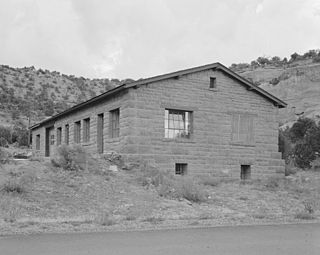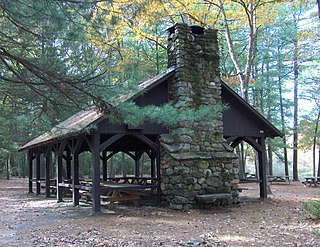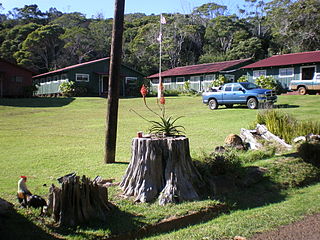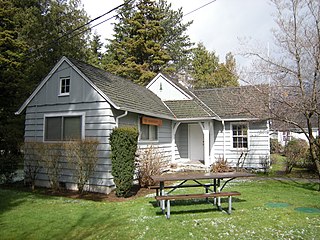
Bandelier National Monument is a 33,677-acre (13,629 ha) United States National Monument near Los Alamos in Sandoval and Los Alamos counties, New Mexico. The monument preserves the homes and territory of the Ancestral Puebloans of a later era in the Southwest. Most of the pueblo structures date to two eras, dating between 1150 and 1600 AD.

Table Rock State Park is a 3,083-acre (12.48 km2) park at the edge of the Blue Ridge Mountains in northern Pickens County, South Carolina. The park includes Pinnacle Mountain, the tallest mountain totally within the state.

Backbone State Park is Iowa's oldest state park, dedicated in 1919. Located in the valley of the Maquoketa River, it is approximately three miles (5 km) south of Strawberry Point in Delaware County. It is named for a narrow and steep ridge of bedrock carved by a loop of the Maquoketa River originally known as the Devil's Backbone. The initial 1,200 acres (490 ha) were donated by E.M. Carr of Lamont, Iowa. Backbone Lake Dam, a relatively low dam built by the Civilian Conservation Corps (CCC) in the 1930s, created Backbone Lake. The CCC constructed a majority of trails and buildings which make up the park.

The Saddlehorn Caretaker's House and Garage, also known as the Stone House, the Rock House, and the Superintendent's Quarters is a house and asset listed as part of the National Register of Historic Places located in the Colorado National Monument.

The Saddlehorn Comfort Station is one of a group of related structures listed on the National Register of Historic Places in Colorado National Monument. The comfort station and the nearby caretaker's house, garage and the Saddlehorn Utility Area Historic District feature a consistent interpretation of the National Park Service Rustic style, featuring coursed ashlar sandstone masonry and log-supported roof structure. The comfort station was designed in 1936 by W.G. Carney of the National Park Service Branch of Plans and Designs, and built by labor from the Works Progress Administration and the Civilian Conservation Corps. Plans specified not only the general layout of the house and garage, but the specific dimensions of each stone and its location, using a technique of "built by detail".

The Saddlehorn Utility Area Historic District in Colorado National Monument comprises a complex of park service buildings, designed by the National Park Service Branch of Plans and Designs in the National Park Service Rustic style. The primary designer was National Park Service architect Kenneth M. Saunders, who employed the local red sandstone in the buildings, which included shops, fuel shed, repair and storage buildings. The buildings were constructed in 1941 by Public Works Administration and Civilian Conservation Corps labor.

The historical buildings and structures of Zion National Park represent a variety of buildings, interpretive structures, signs and infrastructure associated with the National Park Service's operations in Zion National Park, Utah. Structures vary in size and scale from the Zion Lodge to road culverts and curbs, nearly all of which were designed using native materials and regional construction techniques in an adapted version of the National Park Service Rustic style. A number of the larger structures were designed by Gilbert Stanley Underwood, while many of the smaller structures were designed or coordinated with the National Park Service Branch of Plans and Designs. The bulk of the historic structures date to the 1920s and 1930s. Most of the structures of the 1930s were built using Civilian Conservation Corps labor.

The Massacoe Forest Pavilion, also known as the Stratton Brook Park Pavilion, is a historic outdoor pavilion located in Stratton Brook State Park in Simsbury, Connecticut. It was built in 1935 by the Civilian Conservation Corps (CCC), and is a well-preserved example of the Corps' work. It was listed on the National Register of Historic Places in 1986.

The Wonderland Trail is an approximately 93 mile (150 km) hiking trail that circumnavigates Mount Rainier in Mount Rainier National Park, Washington, United States. The trail goes over many ridges of Mount Rainier for a cumulative 22,000 feet (6,700 m) of elevation gain. The trail was built in 1915.

Civilian Conservation Corps Camp in Koke'e State Park is located at Hawaii Route 550, in Waimea, on the island of Kauai, in the U.S. state of Hawaii. It was built in 1935 with lumber that was put into the saltwater and floated to the shore at Port Allen, the seawater adding a natural termite protection to the lumber. The camp was in continual use for forest management, until Hurricane Iwa devastated it in 1982. In the 1990s it was restored through the efforts of the non-profit Hui O Laka environmental group, and is currently open to the public. It was added to the National Register of Historic Places listings in Hawaii on December 20, 1996.

The Gold Creek Ranger Station is located in Humboldt-Toiyabe National Forest in Elko County, Nevada, USA. It was built in 1910 to administer the Ruby Mountains Forest Reserve, which became Humboldt National Forest. The compound was later expanded by labor provided by the Civilian Conservation Corps.

The Caretaker's Cabin is a historic log cabin in the Cedar Breaks National Monument in southeastern Iron County, Utah, United States, that is listed on the National Register of Historic Places (NRHP).

The Visitor Center is a historic log cabin in the Cedar Breaks National Monument in southeastern Iron County, Utah, United States, that is listed on the National Register of Historic Places (NRHP).

The Powder Magazine is a surviving structure of the Civilian Conservation Corps (CCC) camp of the 1707th Company. Located in Ouachita National Forest in the northeast corner of Scott County, Arkansas, it is a small stone and concrete structure about 4 by 3 feet and between 3 and 4-1/2 feet in height. It is located about 50 yards (46 m) south of the T-shaped junction of two forest roads in 1993) on top of a ridge above Dutch Creek. The structure was built to house the camp's explosives, which were typically used by the camp crew for road and bridge building projects.

The CCC Company 741 Powder Magazine Historic District encompasses two structures built by Camp 741 of the Civilian Conservation Corps c. 1936. The camp, the first established in Arkansas, used these structures to store explosive materials used in road and bridge construction projects. The two structures have concrete bases and tops, and have walls of cut fieldstone and concrete. The main magazine is 8 by 16 feet, and the blasting cap storage building is about 10 by 10 feet. The main magazine is located a short way north of Forest Road 177M in Ouachita National Forest; the blasting cap storage building is about 113 metres (371 ft) to its northwest.
The CCC Company 3767 Powder Magazine Historic District encompasses a pair of storage structures built by the Civilian Conservation Corps (CCC) in Ouachita National Forest. It is located northwest of Jessieville, down a short abandoned roadway leading north from the junction of Gladstone Forest Road and Hampo Road. The larger building, which housed explosives used in CCC construction projects, is a roughly 9-by-7-foot stone building, with a separate wall wrapping around its east side. The smaller building, in which blasting caps were stored, is about 4 feet (1.2 m) square stone structure, with a concrete top and floor.

The CCC Company 947 Powder Magazine is a historic powder magazine in the eastern part of Ouachita National Forest. It is located in southern Yell County, about 200 yards (180 m) down a slope north of a ridge running parallel to Forest Road 71. The structure is made of stone and concrete, and is 6 feet (1.8 m) square and 5 feet (1.5 m) high, with a flat concrete roof and floor. The entrance is on the southeast side. The building was erected about 1933 by a crew of the Civilian Conservation Corps, and was used to store explosive materials used in the construction of roads and bridges in the area.

The Stowe CCC Side Camp, now known as the Vermont State Ski Dorm, is a historic residence hall at 6992 Mountain Road in Stowe, Vermont. Built in 1935 by crews of the Civilian Conservation Corps, it is one of the largest surviving CCC-built housing units to survive in the state. It was converted for use as a ski lodge after World War II. It was listed on the National Register of Historic Places in 2002.

The Tunxis Forest Headquarters House is a historic house on North Hollow Road Connecticut Route 20) in Hartland, Connecticut. Built in 1936, it is one of the few surviving houses built in the state by the Civilian Conservation Corps, and now serves as part of the headquarters complex of Tunxis State Forest. It was listed on the National Register of Historic Places in 1986.

The North Bend Ranger Station is a collection of buildings operated by the USDA Forest Service in the Mount Baker-Snoqualmie National Forest. Constructed by the Civilian Conservation Corps (CCC) in 1936, it was added to the National Register of Historic Places in 1991. The multiple buildings indicate the expansion of Forest Service responsibilities from custodial supervision to extensive resource management. North Bend Ranger Station is considered historic both for its distinctive rustic architecture and for its association with the federal New Deal programs.



















